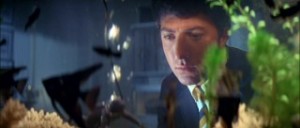After our class screening of Persepolis last night I was still a little perplexed as to what the use of color in the film really might have been meant to convey, other than differentiating between past and present. So, after looking online for a bit, and reading a few articles about the movie I was able to glean enough information to form a theory as to what else this use of color was attempting to convey.
Throughout the movie Marjane is seen to frequently be in conflict with herself, her surroundings, and most noticeably, the people around her. Much of this stems from her disruptive and war torn childhood, which had forced her to move away from her family at the age of thirteen, sparking a long lasting sense of loneliness, guilt, and confusion within her. Even when finally returning to home Marjane was unable to completely adapt back into her old society as she still could not identify fully with her peers, as her time in Vienna was drastically different from what they had experienced back home. While the film progresses onward, these emotions continue and it seems as though Marjane’s life does not really appear to improve. When Marjane finally comes to terms with the fact that she is unhappy with her life in Tehran, her parents tell her she must move out of Iran and find a place where she is actually free to express herself, and thus live her how she sees fit. Although this ends the film at a somber note and it is clear Marjane is sad to leave her family behind, maybe this implies that Marjane is finally leaving her difficult past behind her and has come to terms with who she is and what she really wants out of life.
Therefore, by the director using color during the present, and black and white during the past, he is able to more effectively convey Marjane’s emotional maturity, and that her life may finally change for the better.

